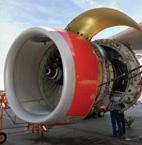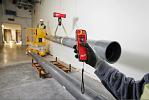- FMA
- The Fabricator
- FABTECH
- Canadian Metalworking
Setting high standards
- April 12, 2010
- News Release
- Measurement
Leon Dodd, corporate director of quality and flight safety, at StandardAero, sounds like a proud father when he talks about his company’s latest achievements in quality standard certification. One of the largest independent aerospace companies in the world devoted to maintenance, repair and overhaul (MRO), StandardAero boasts more than 4,000 employees working at branches based around the world, including Winnipeg.
“Our Winnipeg facility achieved AS9110 accreditation in the summer of 2009. A team of eight key individuals worked for well over a year and a half on a gap analysis, procedural rewrite, internal self-audit by the StandardAero team and corrective actions from the self audit in preparation for the DNV accreditation audit. DNV arrived thereafter conducting a week long audit and the Winnipeg facility passed with flying colours,” exclaims Dodd, who works at StandardAero offices in Maryville, TN.
“Out of the 10 major [company] site locations, StandardAero now has four that are AS9110 accredited and one site will remain accredited to ISO 9001/2000. The remaining five sites are in various stages of certification qualification,” Dodd continues.
The new standard Dodd is referring to—AS9110—is specifically for the maintenance, repair and overhaul sector of the aerospace industry. As developed by the International Aerospace Quality Group (IAQG, a cooperative global organization devoted to providing aviation and space products and services to aerospace firms), AS9110 is based on ISO 9001. It also incorporates elements of the previous standard, AS9100, which applied to all branches of aerospace. The IAQG, which is also responsible for maintaining and revising the standard, released AS9110 in June 2009.
DNV, the company referred to by Dodd, is a certification firm headquartered in Olso, Norway. It is currently one of a handful of companies able to accredit aerospace firms to the AS9110 standard.
AS9110 emphasizes quality, reliability, safety, customer satisfaction, risk management, project management, and configuration management, and contains new measures to combat counterfeit parts. Aerospace suppliers with AS9110 certification face fewer audits from OEMs. Companies that get certified to AS9110 can also be listed in the Online Aerospace Supplier Information System (OASIS), an international database of accredited firms. “The OASIS database allows for the sharing of audit results. The data that is shared is referred to as tier one data [and] is not confidential,” explains Mario Langlois, director of quality assurance and quality control at Bombardier Aerospace.
The motivation behind AS9110 is to promote “true global aviation, space and defence industry cooperation and harmonization, reduced duplication and waste, higher quality products at reduced cost, and open sharing of best practices,” says IAQG.
“AS9110 total system implementation has helped StandardAero focus on part, process and service improvements corporate wide,” says Dodd. “We have teams all over StandardAero working on continuous improvement projects and have demonstrated results financially, in turn-time, cost-reductions, defect reductions and product risk reductions. AS9110 has helped us focus on integration of personnel, tooling, procedures, lighting and ergonomics to ensure that the work we do is airworthy when it leaves our shops.”
As Dodd notes, getting AS9110 certified is not easy. The process begins with an optional pre-assessment. Stage one is a document review. Stage two is an on-site initial audit using a checklist and scoring system. Should the company pass the audit, then AS9110 certification is issued. Certified firms then have a choice of annual or semi-annual auditor surveillance.
The new standard is making waves among a large portion of aerospace firms. According to the Aerospace Industries Association of Canada, the aircraft MRO sector accounted for over $3 billion in aerospace revenues in 2008 and employed 17,000 workers at 1,110 certified aircraft maintenance organizations. Total aerospace revenue and employment in 2008 came to $23.6 billion and 80,000 workers, respectively.
StandardAero is not the only aerospace company with Canadian branches that has become AS9110 certified.
Magellan Aerospace’s Orenda division in Mississauga, ON, which handles MRO work, has also been accredited for living up to this high standard.
“The driver behind [certification] was that our customers were requiring that we were certified,” explains Karen Yoshiki-Gravelsins, director of environmental quality and continuous improvement for Magellan Aerospace, Mississauga, ON.
Orenda was certified by Intertek, a British accreditation firm. All divisions at Magellan—including Orenda—are also certified to the older, across-the-board standard, AS9100. Because Orenda was already AS9100 certified, getting AS9110 accreditation was merely a matter of “tweaking” a few procedures, says Yoshiki-Gravelsins
“The coordinator from each of the divisions is responsible for all the continuing improvement type of activities,” explains Yoshiki-Gravelsins. “[Improvement activities] are broken down into Lean activities and Six Sigma activities. Under Lean, we do Kaizen events, like accelerated improvement workshops. These are corporately done, every quarter, at a different site. We bring in individuals from different divisions so not only does the division [hosting the workshop] benefit, but other divisions are taking back lessons learned.”
The goal of these accelerated improvement workshops is to reduce lead time and inventory, she states.
Magellan has also embraced 5S (five “S”) principles. This is another Japanese workplace methodology aimed at boosting quality and lowering costs. The five “Ss” in question are: sorting, straightening or setting in order, sweeping or systematic cleaning, standardizing and sustaining the discipline.
“On the 5S side, we have standardized checklists we use at all our divisions ... there are a number of criteria that have to be met [and] a scoring system for each of the five elements. So basically with 5S, various [teams] within the facility are striving for the highest score. To create enthusiasm, we have little competitions amongst different areas within a facility as well,” says Yoshiki-Gravelsins.
StandardAero also utilizes a 5S strategy, as well as non-AS9110/AS9100 quality standard programs such as continuous improvement and Lean manufacturing.
In 1989 StandardAero implemented product-focused production cells and simple visual control systems. Dodd adds that “in 2007, StandardAero completed another milestone by designing and implementing continuous flow lines in one of its turboprop business units and designing a unique pull system in the same business unit’s component repair cell. The business unit inventory value was reduced by approximately 50 per cent, while on-time delivery performance increased by a similar amount. Work-in-progress levels in the production cells dropped by 90 per cent and the level of effort required to manage the business decreased dramatically. The twice-a-day production meeting (attended by 15 people) was eliminated, as were the nearly constant build schedule changes.”
For information on AS9110, visit International Aerospace Quality Group’s website http://www.iaqg.org. QC
Nate Hendley is a freelance writer based in Toronto.
subscribe now


Keep up to date with the latest news, events, and technology for all things metal from our pair of monthly magazines written specifically for Canadian manufacturers!
Start Your Free Subscription- Industry Events
MME Winnipeg
- April 30, 2024
- Winnipeg, ON Canada
CTMA Economic Uncertainty: Helping You Navigate Windsor Seminar
- April 30, 2024
- Windsor, ON Canada
CTMA Economic Uncertainty: Helping You Navigate Kitchener Seminar
- May 2, 2024
- Kitchener, ON Canada
Automate 2024
- May 6 - 9, 2024
- Chicago, IL
ANCA Open House
- May 7 - 8, 2024
- Wixom, MI




















